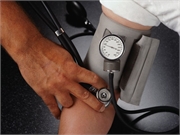Tag: Atrial Fibrillation
Deaths From Atrial Fibrillation Declined From 1972 to 2015
Two-year gap in life expectancy still exists, compared to individuals without atrial fibrillation
Yoga Practice May Benefit Patients With Atrial Fibrillation
Reductions seen in symptomatic AF, nonsymptomatic AF, asymptomatic AF episodes; depression and anxiety
Cardiorespiratory Fitness Linked to Outcomes After A-Fib Ablation
Arrhythmia recurrence rate, mortality significantly lower in those with higher cardiorespiratory fitness
Osteoporotic Fracture Risk Lower for DOAC Than Warfarin in A-Fib
No differences seen in fracture risk in head-to-head comparisons of direct oral anticoagulants
Intensive Blood Pressure Control Tied to Lower Atrial Fibrillation Risk
Lowering systolic BP to <120 mm Hg lowers risk by 26 percent
Dual Therapy Linked to Lower Bleeding Risk in A-Fib After PCI
Low-certainty evidence showed inconclusive effects for all-cause mortality, cardiovascular mortality, MI
Apixaban Seems Safer Than Rivaroxaban for A-Fib
Lower rates seen for ischemic stroke or systemic embolism, GI bleeding or intracranial hemorrhage
Racial/Ethnic Disparity Seen for Stroke in Dialysis Patients With A-Fib
Rates of stroke higher for minority dialysis patients with a-fib partly due to lower anticoagulant use
GI Bleeding in OAC-Treated A-Fib Patients Indicates CRC Risk
Lower-GI bleeding tied to high absolute risks for CRC in patients receiving oral anticoagulants for a-fib
Electrical Cardioversion Effective for Acute A-Fib in Emergency Setting
Both drug-shock, shock-only strategies highly effective; no difference seen for pad positions














